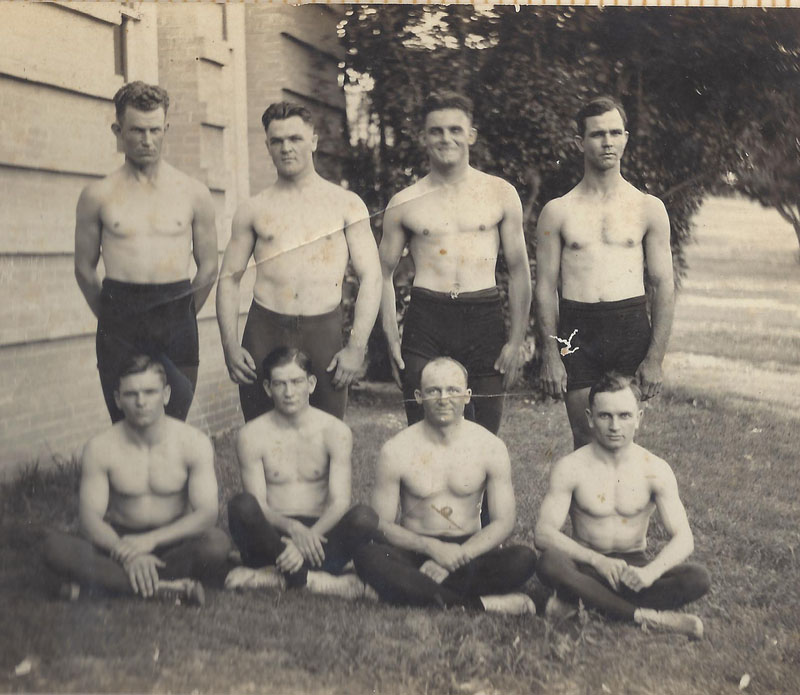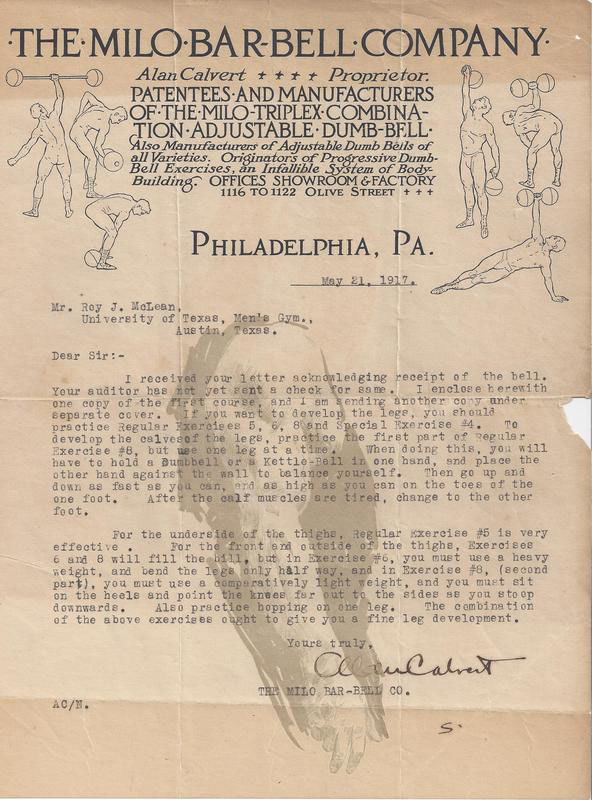Roy McLean
Roy J. McLean, born in Austin in 1897, grew up on the edge of the campus and was a “mascot” for the UT football and baseball teams from 1906-1911. After graduating from Austin High (where he took an extra semester of work to perfect his shorthand, book keeping, and typing skills), McLean entered the University of Texas in the fall of 1913 at age 16. In his first semester at UT he filled his mornings with classes in English, History, Mathematics, Physics, and Spanish, but in the afternoons he had only one class, Physical Training. That class met at the University YMCA building on Guadalupe, where Mclean began spending most of his free time and became friends with newly-named athletic director L. Theo Bellmont. In March of 1914, while still a freshman, the YMCA’s secretary phoned him at home one day to ask him if he could work for Bellmont several hours a day and assist the athletic director with typing and shorthand needs. McLean began that same day and continued to serve in this capacity until his graduation in 1917. That same year, when he was no more than 17, McLean also set up the first accounting system for the Athletic Department, and took over the management of ticket sales for the home football games.
Later that same month, Bellmont introduced McLean to H.J. Lutcher Stark, who’d been the manager of the 1910 football team and would later serve for 24 years on the Board of Regents. (For more on Lutcher Stark, click here). Lutcher had come to campus that day to see his good friend Bellmont and to tell him about his trip to Philadelphia where he had just spent three months learning how to lift weights and eat properly from Alan Calvert, owner of the Milo Barbell Company and the publisher of Strength magazine. McLean later wrote of this important turning point in his life, “Lutcher had dropped by for a visit and to work out with his barbells which he always carried in his car, and which he said had changed him from a 220-pound fat boy into a 180 pound muscular athlete.” In that same personal memoir, McLean recalled that they spent the next several hours with Stark who demonstrated to them the exercises and system of sets and repetitions recommended by Calvert. Further, when Stark left to head home to Orange, Texas, he told Bellmont to keep the Milo Barbell set they’d trained with there on campus, that it was a gift.
He also gave Bellmont a pile of Strength magazines so they could read and learn more about this then little-understood activity. McLean and Bellmont were both impressed by what Stark had shown them that day and as soon as he had saved the funds, McLean ordered his own Milo set to use at home. Following that visit, McLean and Bellmont continued training and Mclean eventually added thirty pounds of muscle to his lanky frame and became a true believer in the benefits of weight training.
McLean also took up wrestling while he was in college and competed on the team during 1915, 1916 and 1917. When War was declared in 1917 McLean and Bellmont both enlisted in the Army Air Corps and were assigned to the School of Military Aeronautics that opened on the campus of UT-Austin. UT was one of eight universities in America that turned over much of their campus to the military; physical training and sports classes became military drill classes and Bellmont even left UT for time to attend flight school.
With the war’s end, McLean returned to UT to work on a Master’s Degree and was offered a teaching and coaching position by Bellmont, in 1920 even though he would not finish hid degree until 1923. However, in his new position, McLean became coach (with no additional pay) of both the wrestling and the cross-country teams and he had his athletes incorporate weight training along with a variety of other conditioning techniques in their training.
Mclean was a great success as a coach. He helped wrestling star Ralph Hammond earn a spot on the 1928 Olympic team and his Longhorns won many conference championships. In cross country, Mclean remained head coach until 1933 when it was decided that Clyde Littlefield would step down as head football coach and take over all track and field teams.
By this time, however, Mclean had found his true calling in the weight room. In 1919 when he began teaching at UT, Mclean requested permission to schedule a class in weight training. The two Milo barbells and several pairs of 10- and 15-pound dumbbells owned my Mclean and Bellmont comprised the equipment for that first class, and the training sessions were held in the wrestling room, in one of the abandoned military barracks on campus. In that first class, McLean had 11 freshmen and none of them had ever seen a barbell before. The other coaches, according to Mclean, forbade their athletes to even touch a weight—and told them it would make them muscle-bound. The eleven male students however, loved the class, and after McLean tested them at the end of the semester and showed them that they could jump higher, run faster, and had more muscle on their bodies, they spread the word to other students and there were soon more young men wanting to take his weight training class than he could handle. And so, additional courses were added, and more Milo barbells were shipped down from Philadelphia.
By 1929 when Gregory Gym was built to house the men’s Physical Training Program, demand was so great that a special weight room was added to the new building to accommodate what had then grown to ten classes per semester. Over the next five decades, interest in weight training continued to grow and in 1967, when Mclean finally retired as an Associate Professor, the men’s physical training program was offering 22 sections of weight training each semester. With 25-30 students approximately in each section, this means that over the course of his long and profitable life, Roy J. McLean taught tens of thousands of Longhorn men how to lift weights.




